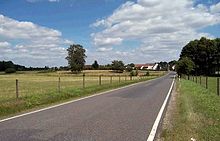Skaska
|
Skaska
community Oßling
Coordinates: 51 ° 20 ′ 46 ″ N , 14 ° 10 ′ 49 ″ E
|
|
|---|---|
| Height : | 140 m above sea level NN |
| Residents : | 253 (Aug 1, 2019) |
| Incorporation : | 1st January 1969 |
| Incorporated into: | Skaska-Dobra |
| Postal code : | 01920 |
| Area code : | 035792 |
Skaska ( Upper Sorbian ) is a village in the north of the East Saxon district of Bautzen . It belongs to Upper Lusatia and has been one of nine districts in the municipality of Oßling since 1994 .
In 1383 Skaska was first mentioned as Skasskaw . Mayor is Olaf Schulze, his deputy Olaf Zinke.
Geography and traffic
Skaska stretches from the southern slope of the Skaska mountain to the Schwarze Elster river . The connection to the national public transport is ensured by the bus line 182. This means that Skaska is connected to the Kamenz , Hoyerswerda and Bischofswerda train stations .
Culture and sights
- Skaskaer Berg Southwest viewpoint, offers a view towards Kamenz and the Upper Lusatian mountain range
- Skaskaer Berg Nordost lookout point, offers a view towards Hoyerswerda, the Jänschwalde, Schwarze Pumpe and Boxberg lignite power stations
- Inselgrube, former coal mine, today DAV fishing waters and small local recreation area
- Bathing pit, former coal mine, today DAV fishing waters and small local recreation area
- Park, centrally located park
- Sports field, operated by the local sports club “SG Ossling / Skaska”, located on the Black Elster
- “Braune Kiste”, a local meeting point open on Tuesdays with beer serving, located on the Black Elster
Until shortly after the end of the Second World War there was a castle in Skaska, which was built and used as a transfer station on his travels to Poland during the time of August the Strong. It was demolished by the Red Army in the late 1940s. The palace park still exists today.
Population and language
Skaska originally belonged to the Upper Sorbian language area . For his statistics on the Sorbian population in Upper Lusatia, Arnošt Muka determined a population of 233 in the 1880s, including 191 Sorbs (82%) and 42 Germans. In 1956 Ernst Tschernik counted a Sorbian-speaking population of only 6.2% in the municipality of Skaska, including only one Sorbian youth. The language has now disappeared from everyday local life.
economy
In the middle of the village is the headquarters of a large agricultural company, Elsteraue Agrar GmbH. To the south there are several large fish ponds. Furthermore, the place has gastronomic facilities: the restaurant Jägerhaus Skaska and "Braune Kiste" at the sports field.
literature
- Cornelius Gurlitt : Skaska. In: Descriptive representation of the older architectural and art monuments of the Kingdom of Saxony. 35. Issue: Amtshauptmannschaft Kamenz (Land) . CC Meinhold, Dresden 1912, p. 330.
- Gustav Adolf Poenicke: Skasska . In: Markgrafenthum Oberlausitz . (= Album of the manors and castles in the Kingdom of Saxony. III. Section.) Leipzig 1859, pp. 54–56. (Digital full text output in Wikisource ).
Web links
- Skaska in the Digital Historical Directory of Saxony
Footnotes and individual references
- ^ Statistics of the community of Oßling. Oßling community, accessed on September 30, 2019.
- ↑ Skaska in the Digital Historical Directory of Saxony
- ^ Community of Oßling (accessed on February 21, 2018)
- ↑ Ernst Tschernik: The development of the Sorbian population . Akademie-Verlag, Berlin 1954.
- ^ Ludwig Elle: Language policy in the Lausitz . Domowina-Verlag, Bautzen 1995, p. 252 .




